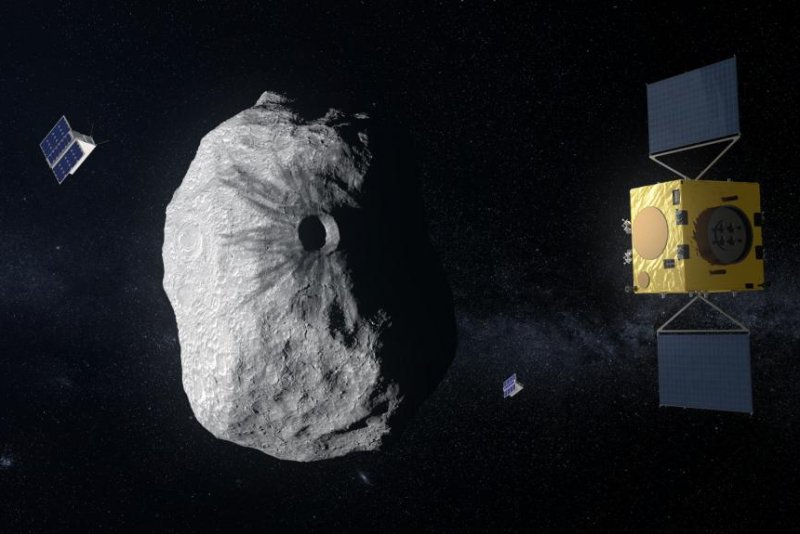An illustration shows the pair of CubeSats orbiting the binary asteroid system alongside the ESA probe Hera. Photo by ESA/ScienceOffice.org
Jan. 7 (UPI) -- With Hera, the European Space Agency is aiming to become the first to put a space probe in orbit around a binary asteroid system. When Hera launches in 2023, it will be carrying at least two CubeSats.
According to a new mission update, the two nanosatellites will be released into orbit around the pair of asteroids and eventually land on the two space rocks.
"We're very happy to have these high-quality CubeSat missions join us to perform additional bonus science alongside their Hera mothership," Hera mission manager Ian Carnelli said in a news release. "Carrying added instruments and venturing much closer to our target bodies, they will give different perspectives and complementary investigations on this exotic binary asteroid. They will also give us valuable experience of close proximity operations relayed by the Hera mothercraft in extreme low-gravity conditions. This will be very valuable to many future missions."
CubeSats are standardized mini satellites measuring roughly four by four by four inches. The toaster-like cubes have become popular tools for space research. Multiple CubeSats can be carried into space and released to form integrated constellations, acting on their own or in coordination with a larger probe.
Last year, a pair of CubeSats helped track the touchdown of NASA's Insight Lander.
"A lot of work went into designing and testing these components so that they could survive the trip to Mars and relay data during InSight's landing," Joel Krajewski, project manager on the MarCO mission and a researcher at NASA's Jet Propulsion Laboratory, said in May. "But our broader goal is to learn more about how to adapt CubeSat technologies for future deep-space missions."
The Didymos asteroid system consists of the minor-planet Didymos and its satellite, or minor-planet-moon, informally named Didymoon. Didymos completes a rotation every 2.26 hours, while its satellite completes an orbit every 11.9 hours. The system is classified as a potentially hazardous asteroid and near-Earth object.
By the time Hera and its two CubeSats reach Didymos in 2026, the asteroid will be historic. If NASA's Double Asteroid Redirection Test, or DART mission, is a success, Didymos will be the first asteroid in history to have its orbital trajectory influenced by humans. NASA plans to crash a spacecraft into the surface of Didymos in an effort to redirect its orbital path into a less threatening pattern. The Hera mission will help measure the physical effects of the DART mission on Didymos.
The two CubeSats on the Hera mission with perform different scientific functions. The Asteroid Prospection Explorer, or APEX CubeSat, will use a spectrometer to analyze the sunlight bouncing off the surface of each of the two objects, characterizing differences in the two space rock's compositions.
The Juventas CubeSat will measure the two objects' gravity fields to help scientists gain a better understanding of the rocks' inner structures. Juventas will also coordinate with Hera, using satellite-to-satellite radio communication to execute a low-frequency radar survey of the asteroid system's internal makeup.















